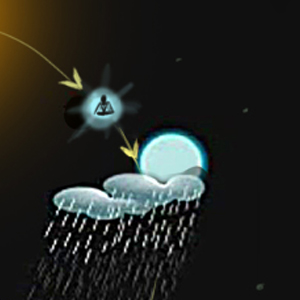When a father sees the traits of his late mother in his daughter, he feels happy that his mother is reborn as his daughter. It could be true. Modern science asserts the genes pass from one generation to the next to show resemblance. Vedic scriptures go beyond genetics to describe a five-phased journey of a departed soul (i.e. a late mother of a person) to the next human body (i.e. reborn as his daughter).
How does a soul travel from one body to another?
When someone dies, the body exists but something leaves the body. That something which leaves the body is the soul. The soul takes nothing with it when leaving the body. Neither money nor fame, nor jewelry nor stocks, not even the spouse or children.
However, Vedic scriptures mention that the soul does carry certain belongings throughout its journey in this universe. However, they are not visible with our mortal eyes.
What does the soul carry when it leaves the current body?
It carries…
These constitute the subtle body in which the soul safely travels. This subtle body carries the records of all past karmas of the soul. It is analogous to a government ID card that when swiped gives the history of our activities. The records of past karmas are ana:di, the beginning is not comprehensible (not only the most recent body but the comprehensive records of all previous bodies). The soul leaves the current body with this subtle body to find its next physical home, the next body!
How does a soul know where to go next?
The association of gunas of 3 types: sattva, rajas, thamas drives the soul to its next destination. These three gunas are the attributes of nature. When the soul attaches to them too firmly wishing for more experience of a particular guna, this generally causes it to come back to Earth to experience more.
.
sri: bhagavan uva:cha
purushah prakruthisttho: hi
bhunkthe: prakruthija:n guna:n|
ka:ranam guna sango::sya
sadasad yo:ni janmasu||
– Bhagavad Githa, Chapter 13, Sloka 21
Depending on which guna the soul is longing to experience, a suitable body that enables the experience is bestowed to that soul. There are 3 broad paths for the soul.
Let’s discuss path two, the journey of the soul when it’s destined to reach another human body on Earth. This journey involves five phases, metaphorically known as the five agnis (sacred fires).
What are the five phases that a soul travels to reach a Human body?
After death, when the gross body is burnt or buried, the soul exits the body with the subtle body. It then passes through time-bound areas in space that define a day, a fortnight, a month, a 6-month period (a:yana) and reaches the first phase, the first fire!
These five agnis or fires (pancha agni) are transition periods leading the soul from one phase to the next, ultimately a new body here on Earth.

(1st Fire)
Dyu Loka – World of Sun
The senses take the lead and offer the soul into the first fire, the rays of Sun.

(2nd Fire)
Parjanya Loka – World of Clouds
The pra:nas take the lead and offer the soul into the second fire, the clouds. The soul stays there until its destined time (maybe even years) to fall as a droplet of water on the Earth.

The Earth
This is a critical phase. The droplet falls on the Earth and reaches the roots of a plant. It then becomes part of the plant that becomes a food item for a human being.
There is every chance that the droplet falls on the Earth at a location such as a dessert, or in a wild-life forest, or polar regions. There is every chance that the droplet does not reach a consumable product. Despite all those, if the soul somehow makes it to becoming a consumable and reaches a human being, then there is still a very small chance of getting a human body in the next phase.

The Male body
A male consumes the grain or the fruit and the soul enters a white blood cell that becomes the spermatozoa, the male reproductive cell.
There is every chance that the soul becomes skin cell, or flesh, or bones, or hair, or even part of the waste. There is every chance that the soul doesn’t make it to becoming the spermatozoa that reach a female body. After all of these filters, if the soul somehow makes it to the female body, then there is a higher chance of getting a human body in the next phase.

The Female body
A female’s womb is the final fire where the soul develops its next gross body, ready to take birth onto Earth as a human being.
Panchamya: vahutho va:paha purusha vachaso:bhavathi
Amongst these 5 fires, there are uncountable chances that the soul may not finish the journey and bind itself with the female egg properly to begin forming a human being. Even then, the pregnancy may not advance to fruition. The chance that we are now in a human body is so infinitesimally small and rare!
So, let’s respect the journey of the soul and realize the significance of this human body. Let’s respond with gratitude. Let’s respect every life around us. Let us practice dharma, the set of practices that keep us safe in this world while paving our way to the ultimate blissful state up in the highest plane.
Let’s not take the human body for granted! Let the five fires rise the appropriate spirit in us to aim for the higher purpose, paramapadam – the ultimate blissful state (Path Three – Archara:di Ma:rga).
– From the discourse of Sri Chinna Jeeyar Swamiji
June 13 th 2020, Pearls from Bhagavatham



Jai Srimanarayana. Good explanation of the travelling of soul after he/ she dies. Various stages depending on the gunas.
||JAI SRIMANNARAYANA|| ||ASMAD GURUBYO NAMAHA|| Swamiji a small doubt! irked into my mind while going through the discourses, as explained in this discourse that human life is so precious and it is not that easy to get a human body, then why does the child in the mother’s womb cry thinking that why has God given him another birth, reminding himself of all the previous karmas and all previous hundreds of births he had since this life is a precious gift given by God to him/her why does the baby cry then? can anyone please clarify my doubt if possible,… Read more »
🙏🏻